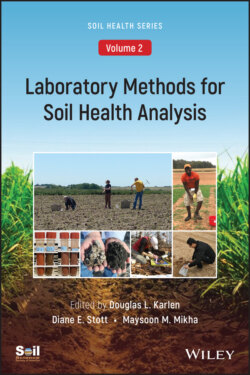Читать книгу Laboratory Methods for Soil Health Analysis, Volume 2 - Группа авторов - Страница 34
General Field Observations
ОглавлениеField‐scale soil health assessments should begin with general field observations such as aboveground biomass, plant growth characteristics and soil conditions. Since these observations are generally part of normal field management practices, they are a logical first step during soil health assessments to determine if more detailed, follow‐up evaluations are warranted. Moreover, much of this information may be obtained through conversations with the land manager. Common field observations outlined by Magdoff and Van Es (2009) include:
Are yields declining?
Do crops perform less well than those on neighboring farms with similar soils?
Do crops quickly show signs of stress or stunted growth during wet or dry periods?Figure 2.2 Generalized approaches to field evaluations of soil health. USDA‐NRCS photo credits: Field observations – Roberto Luciano; Visual soil evaluations – Roberto Luciano; Test kits – Susan Samson‐Liebig; Sensor‐based measurements – Keith Anderson.
Are there symptoms of nutrient deficiencies?
Are there increased problems with diseases or weeds?
Does the soil appear compacted?
Does it take more power to run field equipment through the soil?
Does the soil crust over easily?
Are there signs of runoff and erosion?
Are there changes in soil color?
On‐the‐ground observations of crop and soil conditions can be supplemented with aerial imagery to help identify potential production and environmental issues (Schepers et al., 2004). Doing so can efficiently guide follow‐up evaluations and potential management interventions in affected areas if image locations are georeferenced.
Descriptive soil health field assessments can be translated into semi‐quantitative formats using soil health scorecards. Developed in the early 1990s (Harris and Bezdicek, 1994), scorecards use stakeholder knowledge and field evaluations to identify relevant soil health indicators and assign an associated ranking as being healthy, impaired, or unhealthy (Romig et al., 1996). Scorecards rely on the evaluator’s senses (e.g., sight, feel, smell) and manager input to discern the quality or character of an attribute, making assessments unique to the individual.
Soil health scorecards and other semi‐quantitative evaluation approaches have been developed for many states in the USA following a collaborative process including farmers, conservationists, and scientists to identify relevant indicators and ranking criteria (USDA‐NRCS, 1999). Property‐specific pocket charts have also been developed based on associations between descriptive assessments and laboratory measurements (e.g, soil color categories with ranges of organic matter content) (Alexander, 1971). However, broad application of pocket charts for soil quality assessment has been limited because of the complexity and variability among soils. In the case of soil color, associations with soil organic matter content vary strongly with texture, soil depth, and land use (Wills et al., 2007), thereby constraining chart use to a limited geographical domain.
